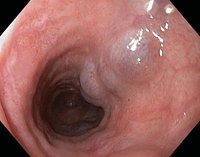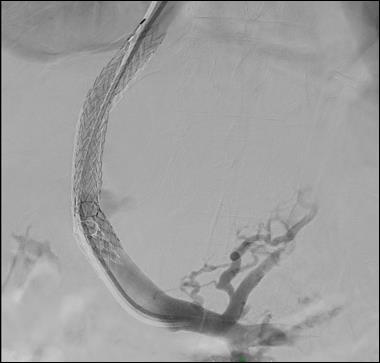[1]
Shaheen AA, Nguyen HH, Congly SE, Kaplan GG, Swain MG. Nationwide estimates and risk factors of hospital readmission in patients with cirrhosis in the United States. Liver international : official journal of the International Association for the Study of the Liver. 2019 May:39(5):878-884. doi: 10.1111/liv.14054. Epub 2019 Feb 25
[PubMed PMID: 30688401]
[2]
Yoon H, Shin HJ, Kim MJ, Han SJ, Koh H, Kim S, Lee MJ. Predicting gastroesophageal varices through spleen magnetic resonance elastography in pediatric liver fibrosis. World journal of gastroenterology. 2019 Jan 21:25(3):367-377. doi: 10.3748/wjg.v25.i3.367. Epub
[PubMed PMID: 30686904]
[3]
Nery F, Correia S, Macedo C, Gandara J, Lopes V, Valadares D, Ferreira S, Oliveira J, Gomes MT, Lucas R, Rautou PE, Miranda HP, Valla D. Nonselective beta-blockers and the risk of portal vein thrombosis in patients with cirrhosis: results of a prospective longitudinal study. Alimentary pharmacology & therapeutics. 2019 Mar:49(5):582-588. doi: 10.1111/apt.15137. Epub 2019 Jan 22
[PubMed PMID: 30671978]
[4]
Nigatu A, Yap JE, Lee Chuy K, Go B, Doukky R. Bleeding Risk of Transesophageal Echocardiography in Patients With Esophageal Varices. Journal of the American Society of Echocardiography : official publication of the American Society of Echocardiography. 2019 May:32(5):674-676.e2. doi: 10.1016/j.echo.2018.11.017. Epub 2019 Jan 18
[PubMed PMID: 30665728]
[5]
Chakinala RC, Kumar A, Barsa JE, Mehta D, Haq KF, Solanki S, Tewari V, Aronow WS. Downhill esophageal varices: a therapeutic dilemma. Annals of translational medicine. 2018 Dec:6(23):463. doi: 10.21037/atm.2018.11.13. Epub
[PubMed PMID: 30603651]
[6]
Laine L. Interventions for Primary Prevention of Esophageal Variceal Bleeding. Hepatology (Baltimore, Md.). 2019 Apr:69(4):1382-1384. doi: 10.1002/hep.30463. Epub 2019 Mar 4
[PubMed PMID: 30561058]
[7]
Reiberger T, Bucsics T, Paternostro R, Pfisterer N, Riedl F, Mandorfer M. Small Esophageal Varices in Patients with Cirrhosis-Should We Treat Them? Current hepatology reports. 2018:17(4):301-315. doi: 10.1007/s11901-018-0420-z. Epub 2018 Nov 7
[PubMed PMID: 30546995]
[8]
Pfisterer N, Riedl F, Pachofszky T, Gschwantler M, König K, Schuster B, Mandorfer M, Gessl I, Illiasch C, Fuchs EM, Unger L, Dolak W, Maieron A, Kramer L, Madl C, Trauner M, Reiberger T. Outcomes after placement of a SX-ELLA oesophageal stent for refractory variceal bleeding-A national multicentre study. Liver international : official journal of the International Association for the Study of the Liver. 2019 Feb:39(2):290-298. doi: 10.1111/liv.13971. Epub 2018 Oct 17
[PubMed PMID: 30248224]
[9]
Aggeletopoulou I, Konstantakis C, Manolakopoulos S, Triantos C. Role of band ligation for secondary prophylaxis of variceal bleeding. World journal of gastroenterology. 2018 Jul 14:24(26):2902-2914. doi: 10.3748/wjg.v24.i26.2902. Epub
[PubMed PMID: 30018485]
[10]
Zampino R, Lebano R, Coppola N, Macera M, Grandone A, Rinaldi L, De Sio I, Tufano A, Stornaiuolo G, Adinolfi LE, Durante-Mangoni E, Battista GG, Niglio A. The use of nonselective beta blockers is a risk factor for portal vein thrombosis in cirrhotic patients. Saudi journal of gastroenterology : official journal of the Saudi Gastroenterology Association. 2018 Jan-Feb:24(1):25-29. doi: 10.4103/sjg.SJG_100_17. Epub
[PubMed PMID: 29451181]
[11]
Wu X, Xuan W, Song L. Transjugular intrahepatic portosystemic stent shunt placement and embolization for hemorrhage associated with rupture of anorectal varices. The Journal of international medical research. 2018 Apr:46(4):1666-1671. doi: 10.1177/0300060517730720. Epub 2018 Jan 17
[PubMed PMID: 29338471]
[12]
Monreal-Robles R, Cortez-Hernández CA, González-González JA, Abraldes JG, Bosques-Padilla FJ, Silva-Ramos HN, García-Flores JA, Maldonado-Garza HJ. Acute Variceal Bleeding: Does Octreotide Improve Outcomes in Patients with Different Functional Hepatic Reserve? Annals of hepatology. 2018 January-February:17(1):125-133. doi: 10.5604/01.3001.0010.7544. Epub
[PubMed PMID: 29311398]
[13]
Kuo SZ, Lizaola B, Hayssen H, Lai JC. Beta-blockers and physical frailty in patients with end-stage liver disease. World journal of gastroenterology. 2018 Sep 7:24(33):3770-3775. doi: 10.3748/wjg.v24.i33.3770. Epub
[PubMed PMID: 30197482]
[14]
Tandon P, Bishay K, Fisher S, Yelle D, Carrigan I, Wooller K, Kelly E. Comparison of clinical outcomes between variceal and non-variceal gastrointestinal bleeding in patients with cirrhosis. Journal of gastroenterology and hepatology. 2018 Oct:33(10):1773-1779. doi: 10.1111/jgh.14147. Epub 2018 May 4
[PubMed PMID: 29601652]
Level 2 (mid-level) evidence


